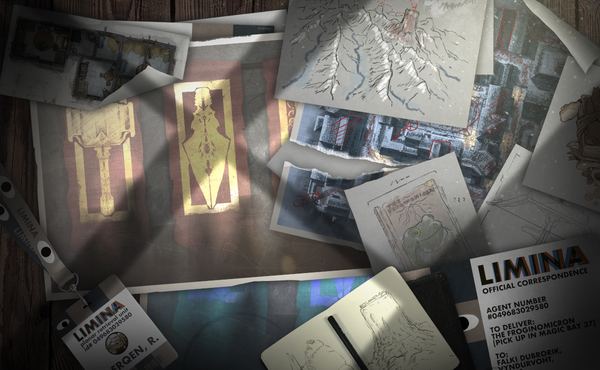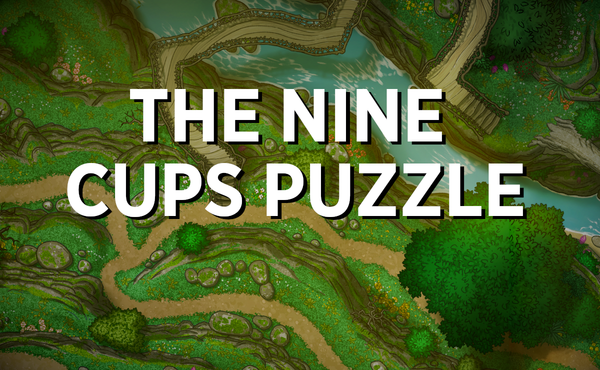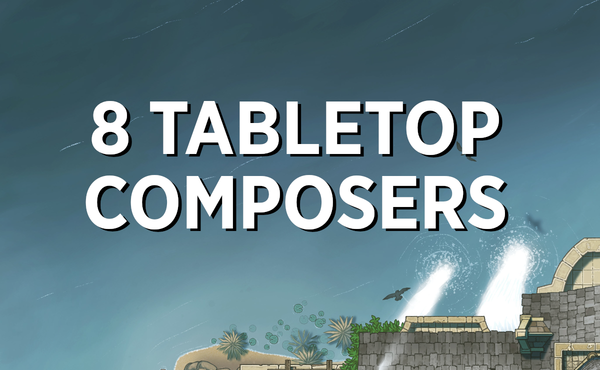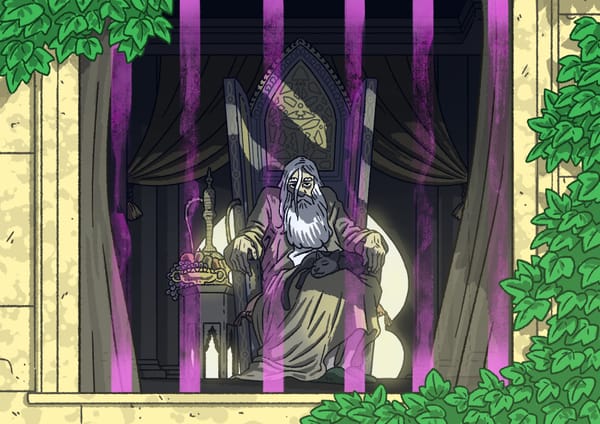Make the Most of Mirror Parties
Mirror parties are a convenient reflection of the player characters. Throw them into a tabletop campaign to force your players to consider who they really are and what they want.

It’s always fun to present your players with a party of adventurer NPCs that function both similarly and in contrast to themselves. These aren’t groups of similarly capable bandits, nor teams of goons led by one noteworthy leader. Instead, it’s an ensemble of 3 to 7 wholly unique characters, each with a dramatically different skill set. This ensemble is a fully fleshed-out party of adventurers—or freelancers, soldiers, etc.—ideally with a wide array of aptitudes and personalities.
Such a “mirror party” can serve many roles in your story, but they also present numerous challenges. Consider the following tips for how best to employ such NPCs.
Much of the content in this post is about our setting of Ancora Bay. Go listen to the album of music we wrote for the sinking port town!
This post is an expanded version of a sidebar from the guide to Borough Bound’s space-fantasy setting Nulvarith. If you want to read an example of incorporating a mirror party in the context of one of our settings, consider picking up the full guide to Nulvarith at our Patreon!

General Tips
Let your players establish the relationship. You may intend for a mirror party to act as rivals, allies, or outright antagonists for your players. When you begin roleplaying the NPCs, however, it can be hard to predict how your players will react. Don’t try to fight this! If your players glom onto the party, slot them into a friendly role, and if your players despise them, set them up as adversaries. You can always morph this relationship over time.
Simplify personalities. Unless your story is all about the rapport between your players and this mirror party, you’ll need to do some very careful characterization to avoid overwhelming your players. Juggling five-or-so completely distinct characters is tough, so give them epithets (e.g., “the warrior,” “the witch,” etc.), unique voices or speaking cadences, and easily summarized personalities. If your friends can’t easily remember who everyone is, they won’t think of each NPC as a distinct character but instead as interchangeable members of the mirror party.
Spotlight your players. Are your players’ characters naïve? Greedy? Stupid? No one is a better judge of a group of adventurers than another group of adventurers. Your mirror party should spell out all of the flaws your players exhibit. Let the contrast between the groups reveal the unique traits of the PC party.
Don’t worry about a 1-to-1 comparison. It’s tempting to provide “doppelgangers” for each of your PCs, a distorted mirror image of each individual. While this might be fun for highlighting the unique quirks of each player and/or their chosen adventuring archetype, it’s also quite a bit more effort and may take your players out of the experience. Providing 1-to-1 matches for each PC is just a bit too on-the-nose unless you’re already running a completely silly campaign.

Give fights as much personality as possible. Whether your players are fighting against or alongside the mirror party, make sure to provide as much character to the NPCs as possible. Ensure their fighting style encapsulates their personality, and keep them talking! Quips, monologues, and mid-fight trash-talking bring so much to a character.
Create competing goals. If the mirror party is completely aligned with your players, there is unlikely to be any interesting conflict. Give the mirror party a goal that is orthogonal to that of the PCs. Maybe both parties want the same artifact but for different purposes, or maybe the two parties want to help each other but have patrons who are at odds. Compelling mirror parties are often at least partially aligned with the PCs.
Example - The Denim Razors
In the middle of one of my long running campaigns—a three-year 5e campaign in the tropical post-apocalyptic world of Roksunay (featuring our setting of Ancora Bay)—the party was contacted via spell by goblin Cedric and his crew. Cedric grew up in an orphanage with the PC party’s cleric, a naïve but good-spirited orc. Cedric claimed that the cleric’s father was not actually dead. Naturally, this prompted the party to travel quite a distance to meet up with Cedric and investigate.
I designed Cedric to be a foil for the cleric. Instead of inexperienced and genuine, Cedric is jaded and manipulative. Of course, the cleric’s father was not alive. Instead, Cedric was trying to lure the party of PCs to a location where they could be easily ambushed. Cedric was working for one of the party’s primary antagonists, and I figured it would be easy to lull the party into a trap by tugging at the cleric’s heartstrings. This worked perfectly!
As soon as the party arrived at the agreed-upon location, Cedric and his crew, “The Denim Razors,” attacked. Normally, I think it’s good to get some personality on display before a fight begins, but this was an ambush, and I knew my players would do a good bit of shit-talking mid-fight. Also, the party had already briefly spoken with the Denim Razors via spell before heading to the ambush. I figured that would be just enough of an introduction to motivate some good roleplaying throughout the combat.
In addition to Cedric (a roguish archetype who relied on dirty tricks), the party also consisted of:
- Eeekee Keek Reekee: an aarakocra “wizard” who pretty much just flew around and recklessly employed stolen spell scrolls
- Millicent St. Abernath: a wicked paladin whose whole shtick is devoting herself to treachery
- Ringus Dingdong: A truly moronic dwarven brute who would attack by smashing his head against foes
The whole idea of this party was to make them very easily hatable but also pretty funny. This made for a fun encounter as the party confronted the diverse tactics the Denim Razors employed while trying to piece together who they were and why they wanted the PCs dead. Plenty of banter ensued throughout the fight.
My players claimed victory and learned what they needed to, and all of the Denim Razors died in the process. Luckily, Cedric’s employer was a necromancer, and so I had the now-zombified crew return for a rematch in a hellish demiplane toward the end of the campaign. The party enjoyed the remixed mechanics, and it was a fun excuse for them to revisit the charming banter they had established.

Why the Denim Razors Worked
- The party met the mirror party before the first combat. The players were able to at least get a sense of the personalities and traits of the Denim Razors in advance, and that made riffing with them and quickly gleaning their whole deal much easier.
- There were only 4 of them. My party had 6 players (yeesh—a bit too big, IMO), but I knew a mirror party that large would be a lot to handle. I kept the Denim Razors to 4, and that worked just fine. Any more and it would have been hard to track it all, and combat would have been a bit unruly. The Denim Razors didn’t have to be a perfect mirror.
- The two parties interacted more than once. There was the initial meeting via spell, the ambush + combat, and then the rematch in hell. This gave the players a chance to gradually establish and deepen their antagonistic rapport with the Denim Razors.
- I leaned into archetypes. The treacherous rogue, the idiot barbarian, the evil paladin, and the heedless spellcaster are easy to track. Yeah, it’s not a ton of nuance, but it made the party members convenient to roleplay, and that made the inter-party banter more compelling.
- There was implied history. The player with the cleric PC didn’t write Cedric into his backstory, but it was acceptable to say “yeah, this guy was also in your orphanage, and you know him.” Use shortcuts for some degree of familiarity when you can!
- They had funny names. It’s unserious, but the moment I named a character “Eeekee Keek Reekee,” I knew my players would either love him or love to hate him. That’s totally in fitting with the tone of my campaigns.

A Quick Second Example
In another long-running campaign, my players regularly interact with a small crew of zealots known as the Trim. The Trim’s overarching goal is to sever their world’s connection to an alternate reality closely linked to their home; the mirror party has their reasons, but my party decided that this would be far too destructive an act to consider. Nevertheless, throughout our campaign, the PCs and the Trim regularly come into contact. They are friends—the players regularly invite the Trim to shindigs at their home base!—but the end goals of the two groups are not aligned.
As the finale of this campaign approaches, it looks like my party is going to rely on the Trim to help out defending a critical location. The two parties may not see eye-to-eye, but there is genuine kinship, and their differences in ideology don't necessarily mean they can’t be allies in unrelated matters.
When first writing the Trim into the story, I had no idea whether my players would end up agreeing with their ideology, killing them on the spot, or keeping them at arm’s reach. I trusted my players to decide for themselves, though. The eventual rapport—that of fair-weather allies—is much more compelling than what I would have tried to prescribe, if that were my MO as a GM.
That’s the beauty of mirror parties. They invite your players to reflect on the characters they’ve created and the goals they seek. Even if a mirror party doesn't fundamentally alter the narrative, it’s fun to roleplay with another group of adventurers. At best, a mirror party can help your players to formalize what they want out of a campaign.




